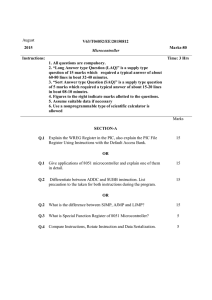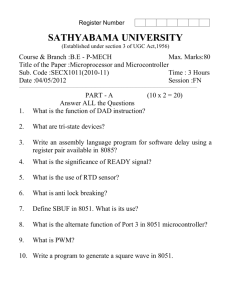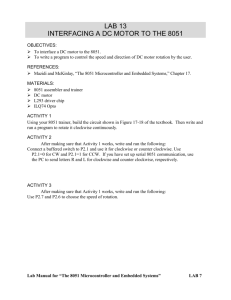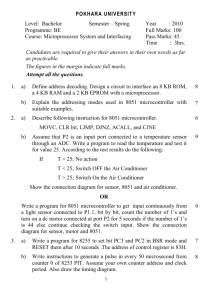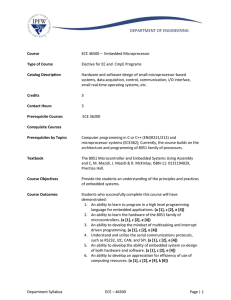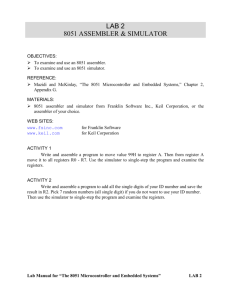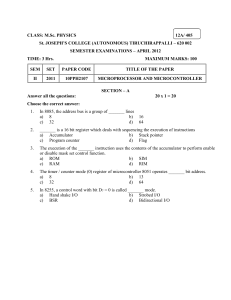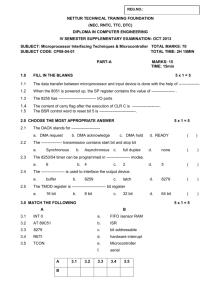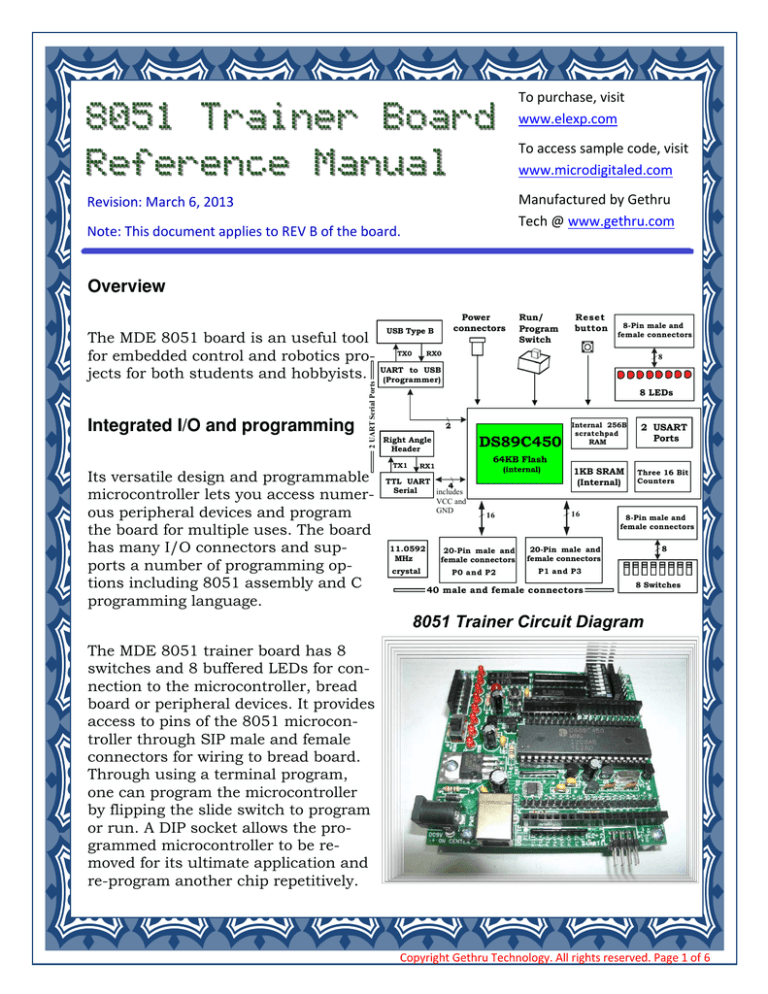
To purchase, visit www.elexp.com 8051 Trainer Board
Reference Manual
To access sample code, visit www.microdigitaled.com Manufactured by Gethru Tech @ www.gethru.com Revision: March 6, 2013 Note: This document applies to REV B of the board. for 8051 textbook. See Overview
Integrated I/O and programming
2 UART Serial Ports
The MDE 8051 board is an useful tool
for embedded control and robotics projects for both students and hobbyists.
Its versatile design and programmable
microcontroller lets you access numerous peripheral devices and program
the board for multiple uses. The board
has many I/O connectors and supports a number of programming options including 8051 assembly and C
programming language.
Power
connectors
USB Type B
TX0
Run/
Program
Switch
Reset
button
8-Pin male and
female connectors
RX0
8
UART to USB
(Programmer)
8 LEDs
DS89C450
Right Angle
Right
Angle
Header
Header
TX1
(internal)
TTL UART
Serial
includes
VCC and
GND
crystal
2 USART
Ports
1KB SRAM
(Internal)
Three 16 Bit
Counters
64KB Flash
RX1
11.0592
MHz
Internal 256B
scratchpad
RAM
16
20-Pin male and
female connectors
P0 and P2
16
8-Pin male and
female connectors
8
20-Pin male and
female connectors
P1 and P3
40 male and female connectors
8 Switches
8051 Trainer Circuit Diagram
The MDE 8051 trainer board has 8
switches and 8 buffered LEDs for connection to the microcontroller, bread
board or peripheral devices. It provides
access to pins of the 8051 microcontroller through SIP male and female
connectors for wiring to bread board.
Through using a terminal program,
one can program the microcontroller
by flipping the slide switch to program
or run. A DIP socket allows the programmed microcontroller to be removed for its ultimate application and
re-program another chip repetitively.
Copyright Gethru Technology. All rights reserved. Page 1 of 6 MDE 8051 Trainer Features include:
A Maxim Integrated DS89C450 microcontroller (an 8051/52 compatible) with 64Kbytes of on-chip Flash
memory
Eight on-board switches accessible
via both male and female connectors
Eight on-board LEDs accessible via
both male and female connectors
An on-board +5V voltage regulator
Two 20-pin male and female connectors for quickly hooking up wires
Support for the Maxim Integrated onchip serial programmer
A Run/Program slide switch
An integrated USB to Serial port
A TTL right angle header to the second Serial COM port
Four threaded stand offs to be easily
mounted onto a chassis
Compact design: Dimensions:
3.44” (W) x 3.46” (L) x 1.47” (H)
Provision of a 2x4 header for an USB
to Serial conversion cable
Features of the Maxim Integrated
DS89C450 Microcontroller include:
On-chip loader using a serial port
Two USART serial interfaces (COM
ports)
Three 16-bit timer counters
64KB program flash
256B scratchpad RAM
1KB on-chip RAM accessible with
MOVX instruction.
For more information on the Maxim
Integrated DS89C450 microcontroller, please refer to the data sheet
available at http://
www.maximintegrated.com
Functional Description
The MDE 8051 Trainer board is designed for embedded control and robotic applications as well as microprocessor experimentation.
The MDE 8051 Trainer board has an
on-chip loader/programmer. The
loader/programmer is accessed via
an USB cable that converts USB to
Serial signal to the serial circuit in
DS89C450.
The MDE 8051 Trainer features an on
-board 5V voltage regulator routed to
system power for VCC and GND pins
and also available on 20 pin male and
female connectors for powering other
ICs on users’ breadboards.
Power Supply
A power adapter is shipped together
with the MDE 8051 Trainer package.
The on-board barrel connector is rated at DC9V, 1 Amp with 2.1mm center positive (+) configuration.
Copyright Gethru Technology. All rights reserved. Page 2 of 6 Plugging in the power adapter will light
up the green LED as a power-on indicator. While working on a breadboard
with jumper wires across VCC and
GND via the headers, one should monitor this green LED to ensure the presence of 5V. Mistakenly wired VCC with
GND can create short-circuit situation
and damage the regulator.
Programming the 8051 Trainer
The MDE 8051 Trainer programming
can be accomplished using the onboard USB connection. Remove power
and connect the USB cable to the PC
and the board first. Once your PC recognizes the MDE 8051 Trainer board
and loads a driver, plug in the power
adapter. The USB converter IC converts signal to Serial Port #0. Programming MDE 8051 Trainer is via Serial
#0 and requires use of the HyperTerminal program or any terminal program
such as Tera Term (http://
en.sourceforge.jp/projects/ttssh2/
releases/). The baud rate settings are
9600, 8 data bits, no parity and 1 stop
bit. For more information on programming the MDE 8051 trainer and access
8051 example codes, please refer to
http://www.microdigitaled.com
serial converter. The second serial port
(#1) has equipped with a 2x4 right angle
male header that has TTL signals of TX,
RX, GND and VCC to be used with an
USB serial cable. Search Google with
keywords “USB 4 TTL” for options.
Crystal Oscillator
The Maxim Integrated DS89C450 microcontroller supports numerous clock
source options for the main processor
operating clock. The MDE 8051 Trainer
has an 11.0592 MHz oscillator crystal.
11.0592 MHz oscillator crystal makes
you enable to connect the 8051 trainer
board to a PC or a Mac and minimize the
transfer error.
RUN/PRGM Programming Switch
To program the MDE 8051 Trainer
board, RUN/PRGM slide switch must be
flipped to the PRGM (right) side. To run
a program after programming, flip the
slide switch to the RUN (left) side.
PORT 0 Pull Up Enable
A jumper JMPR1 can enable or disable
on-board 4.7K Ω pull-up resistors for the
Port 0. The default setting enables the
pull-ups with the jumper cap installed.
Serial Port # 1
The DS89C450 microcontroller provides 2 USART serial interfaces. The
first serial #0 is used with an USB-
User I/O Pins
The 8051 Trainer board has two rows of
male and female connectors for users to
Copyright Gethru Technology. All rights reserved. Page 3 of 6 Access all the ports of the 8051microcontroller. In addition, an isolated 8
position DIP switches and 8 red LEDs
are provided for the use of injecting
signals or verifying output signal’s status.
Flip a DIP slide switch up to obtain a 5V
signal via the headers below the DIP
switches. Similarly, one can feed voltage
via the headers above the LEDs to turn
the corresponding LEDs on.
MDE 8051 Trainer Headers Connection
Note: All 8051 ports can be used as general purpose I/Os or for the following specific purposes.
JP3 and JP4
P0
(Pin 2-9)
JP3 and JP4
P2
(Pin 13-20)
JP1 and JP2
P1
(Pin 1-8)
JP1 and JP2
P1
(Pin 10-17)
MDE 8051 Trainer 20 Pins
Header to DS89C450 Ports / Bit
Pin
Function
Port / Bit
External memory bus
1
VCC
2
AD0
P0.0
3
AD1
P0.1
These pins are accessible for I/O operation. Also
4
AD2
P0.2
they can be connected to the multiplexed
5
AD3
P0.3
Address/Data line of the DS89C450 for external
6
AD4
P0.4
memory bus interface.
7
AD5
P0.5
8
AD6
P0.6
9
AD7
P0.7
10
11
ALE
12
PSEN
External memory bus
13
A8
P2.0
14
A9
P2.1
These pins are accessible for I/O operation. They
15
A10
P2.2
can be connected to the higher order address pins
16
A11
P2.3
of the external memory bus interface.
17
A12
P2.4
18
A13
P2.5
19
A14
P2.6
20
A15
P2.7
1
I/O
P1.0
2
I/O
P1.1
PORT1 is used for I/O operation. If there is an intent3
I/O
P1.2
ion to use the second serial port (#1), P1.2 and P1.3
4
I/O
P1.3
will not be avaiable for I/O operation.
5
I/O
P1.4
P1.2 and P1.3 are connected to UART1 header.
6
I/O
P1,5
7
I/O
P1.6
8
I/O
P1.7
9
Serial port communications and interrupts
10
RxD0
P3.0
11
TxD0
P3.1
Asynchronous serial port, UART0, as well as the
12
INT0I
P3.2
8051 external interrupt sources are part of this port
13
INT1
P3.3
Connection to Serial#0 is used on this port for an
14
T0
P3.4
USB-serial interface. This is used for
15
T1
P3.5
16
WR
P3.6
programming (downloading) the hex file to
17
RD
P3.7
DS89C450 chip. No device can be connected to
18
P3.0 and P3.1 during programming.
19
20
GND
Copyright Gethru Technology. All rights reserved. Page 4 of 6 connector
Description
Dip Switch Connectors
SWITCH
OUTPUT
These pins provide access to switches. It provides
logical zero or one (0 or 5V) for the microcontroller
chip or any external devices.
LED Connectors
INPUT
These pins provide access to the LEDs. Each LED
input is buffered via 74ACT244 and there is no need
PROBE
for external diver.
8051 Trainer 8 Pins Headers
Pin
Function
1
Switch 1 of dipswitch
2
Switch 2 of dipswitch
3
Switch 3 of dipswitch
4
Switch 4 of dipswitch
5
Switch 5 of dipswitch
6
Switch 6 of dipswitch
7
Switch 7 of dipswitch
8
Switch 8 of dipswitch
0
LED 0
1
LED 1
2
LED 2
3
LED 3
4
LED 4
5
LED 5
6
LED 6
7
LED 7
Jumper and UART1 header
Jumper/Header
Label
Function
Pull up Enable / Disable
JMPR1
Use this jumper to enable PORT0 pull ups.
UART1
This is a 2x4 dual row, right angle header. Pin 1, 2 are connected, so are pin 3 and
UART1
pin 4, so are pin5 and pin 6, so are pin7 and pin 8. Pin1,2 are TX1. Pin3,4 are RX1.
Pin5, 6 are ground (0V) . Pin7,8 are VCC (5V)
Component Location diagram can be found next page.
To purchase, visit www.elexp.com
To access sample code, visit www.microdigitaled.com
Designed and manufactured by Gethru Technology www.gethru.com
Copyright Gethru Technology. All rights reserved. Page 5 of 6

